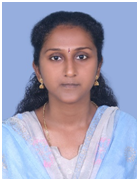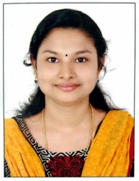Post-Doctoral Fellows – Alumni
| Dr. R. B. Smitha, DST Women Scientist-B | |
| Potential applications of naturally isolated Bacterial strains for the production of Biodegradable Plastics | |
 |
Plastics have become an integral part of our lives – Plastic waste is increasing every year and the precise time needed for biodegradation is unknown. It is proved that Polyhydroxybutyrate (PHB) is a biodegradable material, which has physical properties similar to that of synthetic plastics and are produced by microorganisms in the form of reserved food granules under stress conditions. The main limitation of PHB as biodegradable plastic is its high production cost.Hence freely available E. crassipes can be used to economize the production of PHB. Based on the above facts the project aims to (a). Production enhancement of biodegradable plastics using Eichornia crassipes, (b). Extraction of PHB and quantification of the extracted PHB crystals, (c) to optimize the culture conditions for the maximum production of PHB, (d) Identification and study of the qualitative parameters of PHB crystals, (e). Technology transfer and scaling up activities and (f). Awareness creation on the use of biodegradable plastics. Email: rbsmitha@gmail.com |
| Dr. Neethu R.S., DST Young Scientist Fellow | |
| Evaluation of anticancer and acrylamide reduction potential of fungal L-asparaginase, and development of a low-cost biosensor for leukemia | |
 |
L-asparaginase belongs to amidase group of enzymes that hydrolyses the amide bond in L-asparagine. It has potential applications in food processing in addition to its clinical use. In combination with the other drugs it is used in the treatment of various types of blood cancer. A potential L-asparaginase producing soil fungus was isolated from the forest soil of Wayanad, Kerala and identified by morphological and molecular methods. A low cost production medium for L-asparginase was designed based on the optimization studies conducting using statistical methods like Plackett-Burman and Response Surface Methodology. The enzyme was purified by chromatographic techniques and biochemical characteristics were determined. Further the anti-cancer activity of the purified enzyme is evaluated on cancer cell lines and acrylamide reduction potential on food products is estimated. Once the anticancer potential is determined, a cost-effective microbial L-asparaginase-based biosensor for leukemia will be developed. Email: neethurakeshr@gmail.com |
| Dr. Anoop P. Balan., DST Young Scientist Fellow | |
| Taxonomic and Molecular Biological studies of the genera Tephrosia Pers. and Vigna Savi in India. | |
 |
Taxonomic revision of the genera Tephrosia Pers. and Vigna Savi in India is completed. Updated nomenclature, detailed description, illustration and distribution map of each species prepared. 28 species and 2 subspecies of Tephrosia have been recognised in India. Tephrosia sahyadrica, a new species has been discovered from southern Western Ghats. The specific status of T. pulcherrima (Baker) Wight ex Gamble has been reinstated. T. purpurea (L.) Pers. var. maritima Haines is synonymized to T. purpurea and T. travancorica Thoth. & D.N. Das is synonymized to T. candida DC. 5 names of Tephrosia namely T. calophylla Bedd., T. coccinea Wall., T. pulcherrima (Baker) Wight ex Gamble, T. roxburghiana J.R. Drum. and T. wynaadensis J.R. Drum. are typified. 31 species, 2 subspecies and 4 varieties have been recognized for the genus Vigna in India. Vigna sathishiana and V. idukkiana are newly added to the genus. Email: anooppb01@gmail.com |

